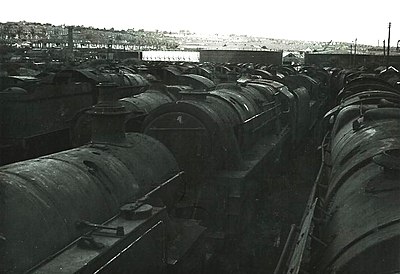Barry Scrapyard
Barry Scrapyard is the colloquial name for Woodham Brothers Ltd, formerly Woodham & Sons, of Thomson Street, Barry, Wales. The scrapyard was responsible for saving more than 200 steam locomotives, including 15 now based at the SVR.
Contents
History
The business was founded in 1892 by Albert Woodham. After his retirement in 1947, the business was run by his youngest son Dai Woodham. It employed around 200 people and encompassed Transport, Marine and Metals as well as the scrap metals business for which it is best known.
Under the Modernisation Plan for British Railways, announced in 1955, more than 500,000 redundant wagons were put out to tender for disposal by BR. Woodham Brothers were one of the scrap dealers invited to take part, and began cutting up wagons in 1957. At the same time BR were withdrawing locomotives faster than their own yards could dispose of them, leading to growing stockpiles of redundant locomotives at Works such as Swindon. Woodham Brothers and other scrap dealers approached BR seeking to scrap these as well as the wagons, and by 1959 Woodhams would become involved in the scrapping of locomotives. The first four locomotives arrived at Barry on 25 March 1959, numbers 5312, 5360, 5392 and 5397.
Locomotives were acquired initially from Swindon and the Western Region and by 1964 from the Southern Region as well. Around 100 steam locomotives were eventually scrapped at Barry or re-sold for disposal elsewhere, of which around 40% were scrapped in the first three years. Thereafter the rate slowed and by 1965 Woodham Brothers decided to concentrate on the simpler process of disposing of wagons in order to generate funds to pay for the locomotives already purchased and acquire others. Post-1965, purchases of locomotives continued at a slower rate but also included a number from the London Midland Region.
By the late 1960s, more than 200 locomotives had reached Barry and were attracting the interest of fledgling preservation groups such as the SVR. The first locomotive to leave the yard was no 43924 in September 1968, destined for the Keighley and Worth Valley Railway. Acquisitions continued even as more locomotives were sold, although the greatest number of locomotives in the yard was thought to be around 221 in mid-1968.
By the early 1980s around 150 locomotives has been ‘saved’ from Barry, with groups such as the ‘Barry Steam Locomotive Action Group’ and ‘Barry Rescue’ being formed to help preserve those remaining. The last ten locomotives passed into the ownership of South Glamorgan County Council (and latterly the Vale of Glamorgan District Council) with the intention of establishing a Welsh Railway Museum. However further sales from the ‘Barry 10’ followed and now in 2016, only 2 ex-Barry locomotives remain at the site which is now the home of the Barry Tourist Railway.
SVR ex-Barry locomotives
Of the 25 locomotives currently resident at the SVR that were owned by BR or the ‘Big 4’ companies, 15 were rescued from Barry. 6 others came direct from BR (1450, 43106, 45110, 46443, 47383 and 48773), 3 from the NCB (813, 1501 and 7714) and one from London Transport (5764).
The current SVR residents ex-Barry are as follows:
| Locomotive | Arrived Barry | Left Barry | Left for | Leaving number |
|---|---|---|---|---|
| 4566 | Aug 1962 | Jul 1970 | SVR | 8 |
| 80079 | Jan 1966 | May 1971 | SVR | 13 |
| 4930 Hagley Hall | Jun 1964 | Jan 1973 | SVR | 29 |
| 5164 | Nov 1963 | Jan 1973 | SVR | 30 |
| 7819 Hinton Manor | May 1966 | Jan 1973 | SVR | 31 |
| 75069 | Jun 1967 | May 1973 | SVR | 37 |
| 42968 | Jun 1967 | Dec 1973 | SVR | 45 |
| 7812 Erlestoke Manor | May 1966 | May 1974 | Dean Forest Railway | 56 |
| 4150 | Aug 1965 | May 1974 | Dean Forest Railway | 57 |
| 2857 | Nov 1963 | Feb 1988 | SVR | 69 |
| 7325 | Nov 1964 | Aug 1975 | SVR | 70 |
| 7802 Bradley Manor | Jul 1966 | Jan 1979 | SVR | 109 |
| 34027 Taw Valley | Dec 1964 | Apr 1980 | NYMR / Hull | 112 |
| 6634 | Nov 1964 | Jun 1981 | Cranmore | 131 |
| 34053 Sir Keith Park | Mar 1966 | Jun 1984 | Hull / Sellindge / Swanage | 153 |
Of these locomotives, only 4150 and 6634 have yet to steam in preservation.
A number of former residents were also rescued from Barry, of which 46521, 4141, and 78019 began their preserved life on the SVR before moving elsewhere. 3612 was purchased from Barry in 1978 as a source of spare parts for the SVR's other panniers, but the frame was later cut up after wheels, boiler and other components were re-used.
The SVR also acquired a quantity of track fixtures and fittings from Barry during visits in 1981, including chair keys, pandrol clips, fishplates and rail anchors.[1]
References
The Barry Story, Beckett and Hardingham, 2010
Links
- ↑ SVR News 61
